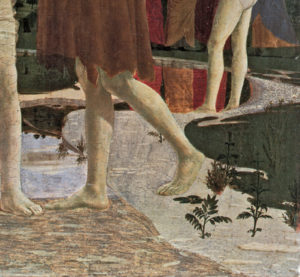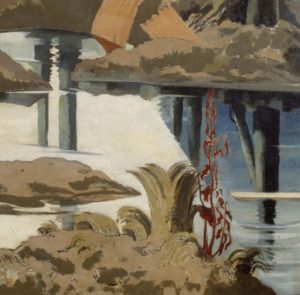Three things happened recently that have prompted me to write a blog piece after a long absence: I saw the Paul Nash exhibition in London, my son is reading Siegfried Sassoon’s war poetry at school, and Trump became the President Elect of the United States. What connects all three is Nash’s painting On Menin Road. It was painted at the end of the First World War as a commission for the British War Memorials Committee.
Nash was sent to the Western Front in early 1917, but was sent home from Ypres that summer after he broke a rib falling into a trench, and a few days later most of his former unit was killed in battle. He returned to Ypres in 1918, not as a soldier but as a war artist, and drew feverishly whilst in the trenches for the last few months of the war. These drawings were his raw material for His masterpiece On Menin Road.
It is a picture of the desolation and despair wrought by war on the landscape, and is almost unbearably moving as an image of the horror of war. Nash has made an extraordinary piece of visual poetry out of the meshing of his personal experience with the new visual language of Cubism and Vorticism that was developing at the time. It’s not often that you can hear the sound of a painting but the clouds from distant shell fire and the jagged shafts of sunlight conjure up the constant booming of explosions and shell fire that the soldiers had to endure. The harsh zigzag of the streams and road cutting across the landscape seem eerily prescient of the Nazi Swastika in the war to come, whilst the dissonant colours: ochre, cerulean, burnt orange, acid yellow, pinks and purples, and bleached out lighting encapsulate the bleakness of the ravaged landscape.
Bizarrely the reflecting shell craters full of acrid water remind me of another great painting with subject matter that could not be further removed from this desecration of the landscape, Piero’s Della Francesca’s Baptism of Christ with uncannily similar identical reflections and plants in the River Jordan by Christ’s feet. I wonder whether this was intended by Nash as a reminder of the complete absence of God in this hellish vision? As a pupil of Henry Tonks at the Slade he did study Piero closely, and was one of the five members of the Neo Primitives along with Stanley Spencer and others. He would have known Piero’s Baptism like the back of his hand.
Nash wrote a letter to his wife whilst drawing on the front describing the horror of the war which I quote below to give you a sense of the emotional and physical tumult that his masterpiece came out of:
‘I have just returned, last night from a visit to Brigade Headquarters up the line and I shall not forget it as long as I live. I have seen the most frightful nightmare of a country more conceived by Dante or Poe than by nature, unspeakable, utterly indescribable. In the fifteen drawings I have made I may give you some idea of its horror, but only being in it and of it can ever make you sensible of its dreadful nature and of what our men in France have to face. We all have a vague notion of the terrors of a battle, and can conjure up with the aid of some of the more inspired war correspondents and the pictures in the Daily Mirror some vision of battlefield; but no pen or drawing can convey this country—the normal setting of the battles taking place day and night, month after month. Evil and the incarnate fiend alone can be master of this war, and no glimmer of God’s hand is seen anywhere. Sunset and sunrise are blasphemous, they are mockeries to man, only the black rain out of the bruised and swollen clouds all though the bitter black night is fit atmosphere in such a land. The rain drives on, the stinking mud becomes more evilly yellow, the shell holes fill up with green-white water, the roads and tracks are covered in inches of slime, the black dying trees ooze and sweat and the shells never cease. They alone plunge overhead, tearing away the rotting tree stumps, breaking the plank roads, striking down horses and mules, annihilating, maiming, maddening, they plunge into the grave, and cast up on it the poor dead. It is unspeakable, godless, hopeless. I am no longer an artist interested and curious, I am a messenger who will bring back word from the men who are fighting to those who want the war to go on for ever. Feeble, inarticulate, will be my message, but it will have a bitter truth, and may it burn their lousy souls.’
In this new potentially isolationist, nationalist world order with Trump in charge, Nash’s extraordinarily powerful painting and writing provide a stark reminder of the endgame of similarly misguided policies one hundred short years ago.



